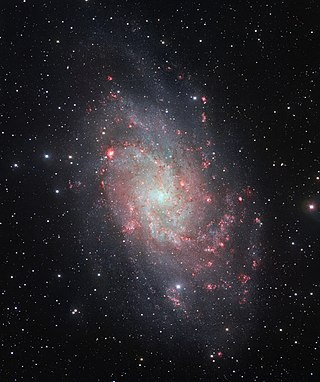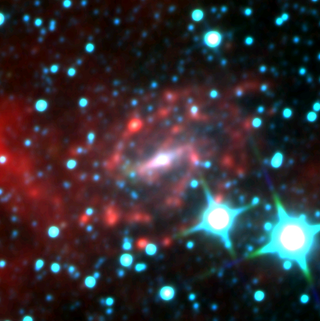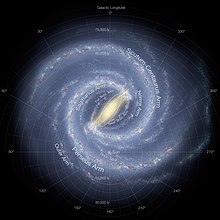
A galaxy is a system of stars, stellar remnants, interstellar gas, dust, and dark matter bound together by gravity. The word is derived from the Greek galaxias (γαλαξίας), literally 'milky', a reference to the Milky Way galaxy that contains the Solar System. Galaxies, averaging an estimated 100 billion stars, range in size from dwarfs with less than a hundred million stars, to the largest galaxies known – supergiants with one hundred trillion stars, each orbiting its galaxy's center of mass. Most of the mass in a typical galaxy is in the form of dark matter, with only a few percent of that mass visible in the form of stars and nebulae. Supermassive black holes are a common feature at the centres of galaxies.

The Triangulum Galaxy is a spiral galaxy 2.73 million light-years (ly) from Earth in the constellation Triangulum. It is catalogued as Messier 33 or NGC (New General Catalogue) 598. With the D25 isophotal diameter of 18.74 kiloparsecs (61,100 light-years), the Triangulum Galaxy is the third-largest member of the Local Group of galaxies, behind the Andromeda Galaxy and the Milky Way.

Spiral galaxies form a class of galaxy originally described by Edwin Hubble in his 1936 work The Realm of the Nebulae and, as such, form part of the Hubble sequence. Most spiral galaxies consist of a flat, rotating disk containing stars, gas and dust, and a central concentration of stars known as the bulge. These are often surrounded by a much fainter halo of stars, many of which reside in globular clusters.

Dwingeloo 1 is a barred spiral galaxy about 10 million light-years away from the Earth, in the constellation Cassiopeia. It lies in the Zone of Avoidance and is heavily obscured by the Milky Way. The size and mass of Dwingeloo 1 are comparable to those of Triangulum Galaxy.

The Orion Arm, also known as the Orion–Cygnus Arm, is a minor spiral arm within the Milky Way Galaxy spanning 3,500 light-years in width and extending roughly 10,000 light-years in length. This galactic structure encompasses the Solar System, including Earth. It is sometimes referred to by alternate names such as the Local Arm or Orion Bridge, and it was previously identified as the Local Spur or the Orion Spur. It should not be confused with the outer terminus of the Norma Arm, known as the Cygnus Arm.

A barred spiral galaxy is a spiral galaxy with a central bar-shaped structure composed of stars. Bars are found in about two thirds of all spiral galaxies in the local universe, and generally affect both the motions of stars and interstellar gas within spiral galaxies and can affect spiral arms as well. The Milky Way Galaxy, where the Solar System is located, is classified as a barred spiral galaxy.

The Carina–Sagittarius Arm is generally thought to be a minor spiral arm of the Milky Way galaxy. Each spiral arm is a long, diffuse curving streamer of stars that radiates from the Galactic Center. These gigantic structures are often composed of billions of stars and thousands of gas clouds. The Carina–Sagittarius Arm is one of the most pronounced arms in our galaxy as many HII regions, young stars and giant molecular clouds are concentrated in it.

The Perseus Arm is one of two major spiral arms of the Milky Way galaxy. The second major arm is called the Scutum–Centaurus Arm. The Perseus Arm begins from the distal end of the long Milky Way central bar. Previously thought to be 13,000 light-years away, it is now thought to lie 6,400 light years from the Solar System.

The Scutum–Centaurus Arm, also known as Scutum-Crux arm, is a long, diffuse curving streamer of stars, gas and dust that spirals outward from the proximate end of the Milky Way's central bar. The Milky Way has been posited since the 1950s to have four spiral arms — numerous studies contest or nuance this number. In 2008, observations using the Spitzer Space Telescope failed to show the expected density of red clump giants in the direction of the Sagittarius and Norma arms. In January 2014, a 12-year study into the distribution and lifespan of massive stars and a 2013-reporting study of the distribution of masers and open clusters both found corroboratory, though would not state irrefutable, evidence for four principal spiral arms.

The Norma Arm is a minor spiral arm of the Milky Way extending from and around its central hub region. The inner portion of the Arm is called the Norma Arm in narrow meaning. The outer end of it is identified either with the Cygnus Arm, which lies outside the Perseus Arm, or the Outer Arm, which is located farther away from the center of the Galaxy than the Cygnus Arm. The Norma Arm begins 2.2 kpc from the Galactic Center, and extends outward to a radius of 15.5±2.8 kpc. It is named for the Norma constellation, through which the Arm as seen from Earth passes.

The 1.2 meter Millimeter-Wave Telescope at the Center for Astrophysics | Harvard & Smithsonian and its twin instrument at CTIO in Chile have been studying the distribution and properties of molecular clouds in our galaxy and its nearest neighbours since the 1970s. The telescope is nicknamed "The Mini" because of its unusually small size. At the time it was built, it was the smallest radio telescope in the world. Together, "The Mini" and its twin in Chile have obtained what is by far the most extensive, uniform, and widely used galactic survey of interstellar carbon monoxide. "The Mini" is currently in operation from October to May each year.

The Milky Way is the galaxy that includes the Solar System, with the name describing the galaxy's appearance from Earth: a hazy band of light seen in the night sky formed from stars that cannot be individually distinguished by the naked eye. The term Milky Way is a translation of the Latin via lactea, from the Greek γαλαξίας κύκλος, meaning "milky circle". From Earth, the Milky Way appears as a band because its disk-shaped structure is viewed from within. Galileo Galilei first resolved the band of light into individual stars with his telescope in 1610. Until the early 1920s, most astronomers thought that the Milky Way contained all the stars in the Universe. Following the 1920 Great Debate between the astronomers Harlow Shapley and Heber Doust Curtis, observations by Edwin Hubble showed that the Milky Way is just one of many galaxies.
The anticenter shell or anticenter superbubble is a region near the anticenter of the Milky Way Galaxy that emits 21 cm radiation. It is located at 06h 27m +15°, or l = 197°, b = +2° in galactic coordinates, near the border of the constellations Gemini and Orion. It is a supershell within our galaxy that is spherical in shape and features jets of gas.

Sagittarius A is a complex radio source at the center of the Milky Way, which contains a supermassive black hole. It is located in the constellation Sagittarius, and is hidden from view at optical wavelengths by large clouds of cosmic dust in the spiral arms of the Milky Way. The dust lane that obscures the Galactic Center from a vantage point around the Sun causes the Great Rift through the bright bulge of the galaxy.
RSGC3 is a young massive open cluster belonging to the Milky Way galaxy. It was discovered in 2010 in the GLIMPSE survey data. The cluster is located in the constellation Scutum at the distance of about 7 kpc from the Sun. It is likely situated at the intersection of the northern end of the Long Bar of the Milky Way and the inner portion of the Scutum–Centaurus Arm—one of its two major spiral arms.

The Near 3 kpc Arm was discovered in the 1950s by astronomer van Woerden and collaborators through 21-centimeter radio measurements of HI. It was found to be expanding away from the center of the Milky Way at more than 50 km/s. This spiral arm contains about 10 million solar masses of gas, mostly hydrogen atoms and molecules. It is named for its distance from the Galactic Center. It is about 5.2 kpc from the Sun, and is located in the fourth galactic quadrant.
High-velocity clouds (HVCs) are large collections of gas found throughout the galactic halo of the Milky Way. Their bulk motions in the local standard of rest have velocities which are measured in excess of 70–90 km s−1. These clouds of gas can be massive in size, some on the order of millions of times the mass of the Sun, and cover large portions of the sky. They have been observed in the Milky Way's halo and within other nearby galaxies.

In astrobiology and planetary astrophysics, the galactic habitable zone is the region of a galaxy in which life might most likely develop. The concept of a galactic habitable zone analyzes various factors, such as metallicity and the rate and density of major catastrophes such as supernovae, and uses these to calculate which regions of a galaxy are more likely to form terrestrial planets, initially develop simple life, and provide a suitable environment for this life to evolve and advance. According to research published in August 2015, very large galaxies may favor the birth and development of habitable planets more than smaller galaxies such as the Milky Way. In the case of the Milky Way, its galactic habitable zone is commonly believed to be an annulus with an outer radius of about 10 kiloparsecs (33,000 ly) and an inner radius close to the Galactic Center.
Thomas M. Dame is Director of the Radio Telescope Data Center at the Center for Astrophysics | Harvard & Smithsonian, a Senior Radio Astronomer at the Smithsonian Astrophysical Observatory, and a Lecturer on Astronomy at Harvard University. He is best known for mapping the Milky Way galaxy in Carbon Monoxide and for the discovery of both the Far 3 kpc Arm and the Outer Scutum–Centaurus Arm of the Milky Way.

NGC 6753 is a massive unbarred spiral galaxy, seen almost exactly face-on, in the southern constellation of Pavo. It was discovered by the English astronomer John Herschel on July 5, 1836. The galaxy is located at a distance of 142 million light years from the Milky Way, and is receding with a heliocentric radial velocity of 3,140 km/s. It does not display any indications of a recent interaction with another galaxy or cluster.













